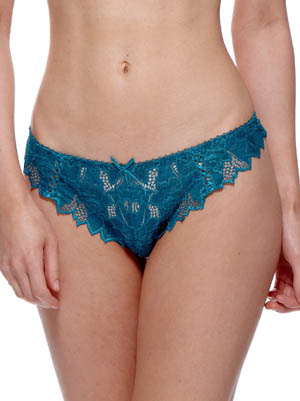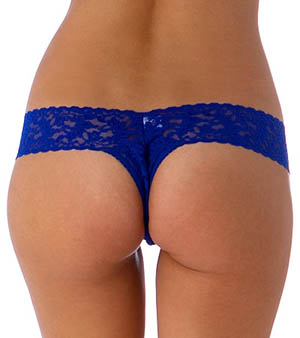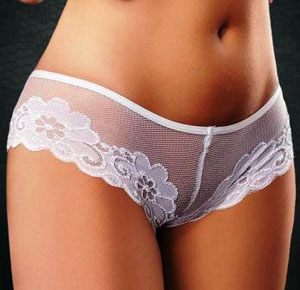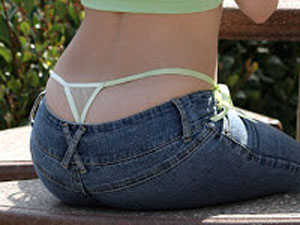The thong is a garment generally worn as either underwear or as a swimsuit in many industrialized societies around the world. It may also be worn for traditional ceremonies or competitions such as sumo wrestling.
Viewed from the front, the thong typically resembles a bikini bottom, but at the back the material is reduced to a minimum. Thongs are almost always designed to cover the genitals, pubic hair, anus, and perineum, and leave part or most of the buttocks uncovered. The back of the garment typically consists of a thin waistband and a thin strip of material, designed to be worn between the buttocks, that connects the middle of the waistband with the bottom front of the garment. It is also used as a descriptive term in other types of garment, such as a bodysuit, bodystocking, leotard or onepiece swimsuit in the context, “thong backed.”
One type of thong is the G-string, the back of which consists only of a (typically elasticized) string.The two terms G-string and thong are often used interchangeably; however, they can refer to distinct pieces of clothing. Thongs come in a variety of styles depending on the thickness, material, or type of the rear portion of fabric and are available for both men and women throughout most of the world.
Nomenclature

The origin of the word thong in the English language is from Old English thwong, a flexible leather cord.
Many languages borrow the English word string to refer to this type of underwear, usually without the G. Another common name is tanga (or sometimes, string tanga), especially in the German Tanga. A frequent metaphor, especially in South America, is dental floss as in Spanish hilo dental or Portuguese fio dental (the Brazilian word for thong); in English, the term “Butt floss” is sometimes used. In Lithuanian it is “siaurikės” (“narrows”), Italian “perizoma” or “tanga”, in Turkish “ipli külot” (“stringed underpants”), and in Bulgarian as “prashka” (slingshot). In Israel the thong, mostly the G-string, is called Khutini (חוטיני), from the word Khut, which means String. Similarly, in Iran, it is called “Shortbandi” (شورت بندی) in which “short” (from English: Shorts) means “briefs” and “bandi” means “with a string”. A Puerto-Rican Spanish slang term, used by Reggaeton artists, is gistro. Australians often colloquially refer to the G-string as a g-banger or simply banger.
In some names for the thong, the bareness of the buttocks is noted, as in Spanish colaless (the origin is probably connected to the term topless but in reference to cola, colloquial term for butt in South American Spanish), and in other names the “T”-like shape of the back is highlighted. In the dialects of Chinese language, the T-back is commonly called dingziku (丁字褲/丁字裤) which literally means 丁 character pants (or roughly, T-letter pants). In Korean, it is called 티팬티 (T panty). However, there are several usages of the term T-back in English as well (e.g., Children’s literature author E. L. Konigsburg’s T-backs, T-shirts, Coat and Suit).
Thong vs. G-string
According to the Encyclopedia of Clothing and Fashion “The G-string, or thong, [is] a panty front with a half- to one-inch strip of fabric at the back that sits between the buttocks”, and Knickers: a Brief History says: “Minor tweaks to the cut earned these skimpy panties different titles—from the thong, which has a one-inch strip of fabric down the back, to a G-string, which, as the name equivalent of Spanish suggests (hilo dental), is more like a string of fabric akin between the teeth.” Striptease: the Untold History of the Girlie Show says: “The thong [is] an undergarment derived from the stripper’s G-string”, and according to Americanisms: the Illustrated Book of Words Made in the USA a G-string is “a thong panty consisting of a small triangular piece of fabric supported by two elastic straps. Attributed to strippers circa 1936”. The Heinemann English Dictionary defines “thong” as “a pair of underpants or swimming costume in a very skimpy style like a G-string”.
History

The thong, like its probable predecessor the loincloth, is believed to be one of the earliest forms of human clothing and is also thought to have been worn mostly or exclusively by men. It is thought the thong was probably originally developed to protect, support, or hide the male genitals. The loincloth is probably the earliest form of clothing used by mankind, having originated in the warmer climates of sub-Saharan Africa where clothing was first worn nearly 75,000 years ago. Many tribal peoples, such as some of the Khoisan people of southern Africa, wore thongs for many centuries. Much like the Japanese fundoshi, these early garments were made with the male genitalia in mind.
A descendant of the loincloth and thong is the jockstrap, created by Chicago sporting goods company Sharp & Smith in 1874. The first historical reference to the thong since then is in 1939 New York City when Mayor Fiorello LaGuardia ordered nude dancers to dress more appropriately.
Jacques Heim’s and Louis Réard’s original bikini from 1946 (that introduced the term bikini) had a culotte with a thong back. Fashion designer Rudi Gernreich, who had in the mid-1960s created the first topless swimsuit, which he called the monokini, is credited with introducing the modern thong in 1974.
In the 1990s, the thong began to gain wider acceptance and popularity in the United States as underwear (and, to a lesser extent, as swimwear), especially with women, but also men. In the USA and Europe, the wearing of thongs by men was once mainly limited to the dance belt, the posing pouch for bodybuilders and the realm of male strippers. Men’s thongs are now more widely available and commonly worn as day-to-day underwear or swimwear. They are not marketed as strongly to men as they are to women. In Europe thongs have been commonplace for many more years both as underwear and swimwear.
Design and variety

Types of thongs include the traditional thong, the G-string, and the C-string. There are a number of intermediate kinds of thongs between full rear coverage and a string rear. As designs become more risqué there are also types intended to expose genitals as much as they conceal them. Other styles include the Cheeky, V-string, and T-back. The naming of the intermediate styles of thong is debatable, different vendors use the words somewhat interchangeably.
Thongs are available in a wide variety of materials, including silk, cotton, microfiber, satin, nylon, and lycra/spandex.
The most significant difference between thongs designed for men and women is the shape of the front part of the garment. Often, but not always, thongs for men will feature a vertical seam to create shape and space for the male genitalia, and the pouch may be made of stretchy material (usually cotton-Lycra or microfiber) for an ergonomic fit. The equivalent section in women’s thongs is normally flat and seamless. However, the fabric is usually thicker in the area where it covers the vulva (by incorporating a cotton gusset) and this is done for several reasons, e.g. leukorrhea.[citation needed] There are also novelty designs for both sexes, featuring shapes to conform to the genitals or provide humorous visual effects.
Women’s thongs
G-string

The G-string style consists of an elastic string, as opposed to a strip of fabric, connecting the front/pouch and the waistband at back. Since the mid-1920s, female strippers and exotic dancers in the West have been referring to the style of thongs they wore for their performances as G-strings. The origin of the term G-string is obscure. Since the 19th century the term geestring referred to the string which held the loincloth of American Indians and later referred to the narrow loincloth itself. William Safire in his Ode on a G-String quoted the usage of the word G-string for loincloth by Harper’s Magazine 15 years after Beadle’s and suggested that the magazine confused the word with the musical term G string (i.e., the string for the G note). Safire also mentions the opinion of linguist Robert Hendrickson that “G” (or “gee”) stands for groin, which was a taboo word at the time. The V-string and T-back are common types of G-string. The G-string thong is commonly found being worn at beaches and nude beaches in the 21st Century.
V-string

A type of G-string in which the string is conected to the waistband by a triangle that is just above the butt. The string connects with the waistband directly to form a “T” shape at back.
C-string

As narrow as a G-string, but without the supporting “string” around the wearer’s hips/panty line, leaving just a sideways C shaped piece between the legs. This is held in place firmly by a flexible internal frame. Since there is no material around the waist, the C-string completely eliminates the panty lines which thongs and other underwear create. C-strings are also designed for use as beachwear, which reduces the tan lines that would have been left by the side straps of even a G or V-String.
Cheeky

A more conservative style called a cheeky covers a little more area, but exposes the bottom part of the buttocks. Some cheekies are used as undergarments while others function as bikini bottoms.
Health Concerns

As thongs pass between the buttocks and may be in close contact with the anus and labia, concerns have been raised that they may become damp and act as a conduit for germ transfer, increasing the probably of the wearer developing urinary tract infections, such as cystitis.
Society

Attitudes to the wearing of g-strings vary geographically and across societies, as is usual with highly revealing clothing. Prior to its entrance into mainstream fashion, g-strings were primarily worn by exotic dancers. In the modern Western world, g-strings are more commonly marketed towards females but are worn by both sexes. By the late 1980s, the style (for females) had made its way into most of the Western world, thong and g-string underwear became more and more popular through the 1990s due to shows like Baywatch, where numerous females were recorded wearing thong swimsuits.
Recent surveys place the number of American women who wear thongs as their preferred underwear style at 28%. While thongs are available for girls as young as eight years it is common for parents to not approve of girls wearing them until they reach their teens. Many reasons exist why women and men may choose to wear thong underwear or swimwear: prevention of visible panty lines; prevention of ride up so one needn’t pull at one’s underwear in public; comfort; fashion consciousness, including the feeling of being more adult; and minimization of tan lines.
In the late 1990s and early 2000s, some people wore thongs with low-cut hipsters and deliberately exposed them over the top of their trousers. This led to many designs of thong intended to be worn in this manner, which were adorned with jewels and motifs on the back. However, in the later 2000s, the exposure of a thong above one’s pants became a less popular and the trend turned to the wearing of lower-riding thongs that hardly show above trousers, except when bending or twisting.
Acceptance as swimwear
Thong swimsuits are generally accepted to some degree in most western countries, including most of Europe, North and South America, Australia, and parts of Asia. On the other hand, thongs are banned or strongly discouraged in some places, including some Muslim countries such as Iran and Saudi Arabia, but also in such locations as Myrtle Beach, South Carolina, and Kure Beach, North Carolina There is no national law specifically relating to nudity, thongs, or toplessness in the United States. At least one U.S. city passed an anti-nudity ordinance in 2007 which however did not ban thongs.
Controversy
Several institutions have banned thongs, mainly schools and universities. In one particular case in 2002, a high school vice principal in San Diego physically checked up to 100 female students’ underwear as they entered the school for a dance, with or without student permission, causing an uproar among students and some parents and eliciting an investigation by the school into the vice principal’s conduct. In her defense, the vice principal said the checks were for student safety and not specifically because of the wearing of thongs (“This was a safety issue, it was not a choice of underwear issue”).
Of particular controversy is the retail by several outlets, including Abercrombie & Fitch, Argos, and Etam, of thongs for children as young as seven, due to their previous association with nude or erotic dancers. A spokesman for Abercrombie & Fitch stated that he could list “at least 100 reasons why a young girl would want thong underwear.”This controversy spawned a great deal of free publicity for Abercrombie, including a chain letter that received wide circulation. Media attention was drawn to the phenomenon when a British primary head teacher voiced concerns that pupils as young as 10 were wearing thong underwear to school.


